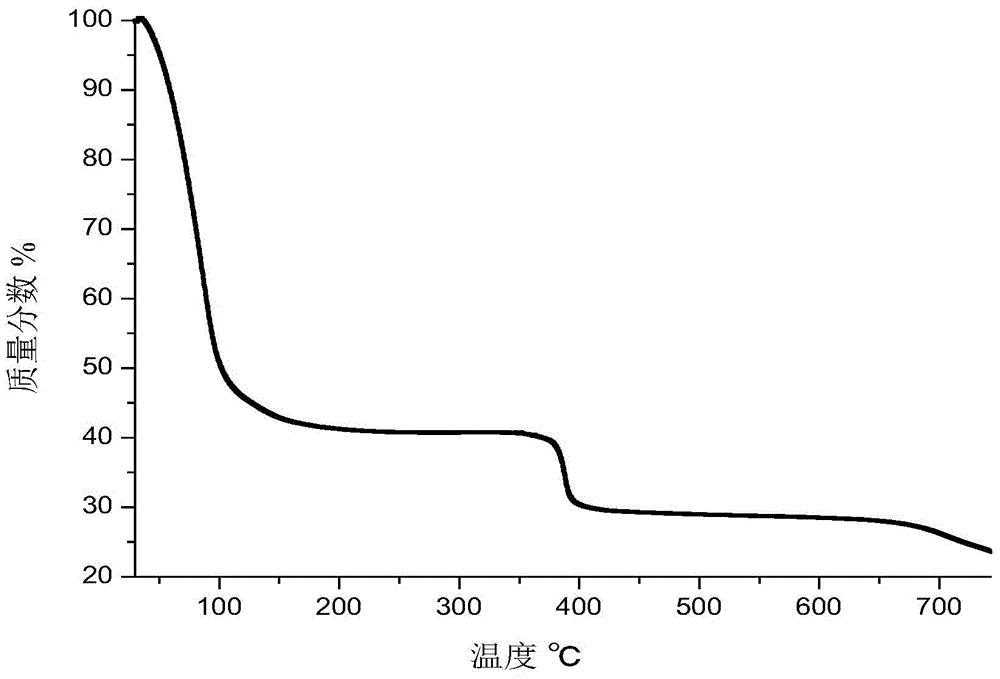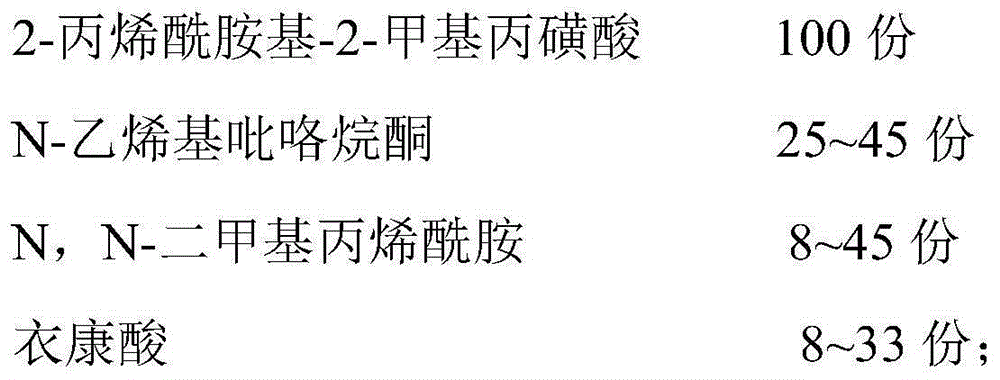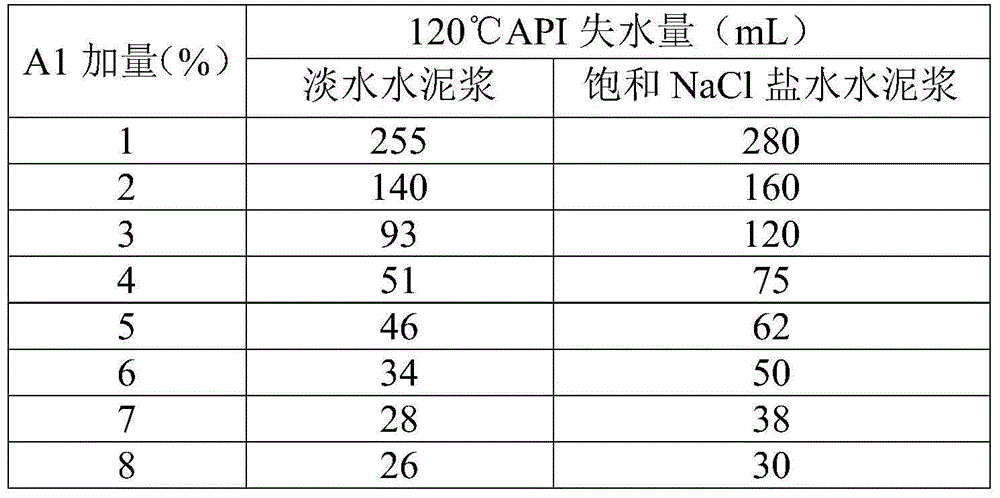Fluid loss additive for oil well cement as well as preparation method and application of agent
A technology of fluid loss reducer and oil well cement, applied in the direction of chemical instruments and methods, drilling compositions, etc., can solve the problems of delayed cement slurry thickening time, excessive cement slurry retardation, thickening time upside down thickening time, etc. problem, to achieve the effect of good thickening line shape, moderate compressive strength and low initial consistency
- Summary
- Abstract
- Description
- Claims
- Application Information
AI Technical Summary
Problems solved by technology
Method used
Image
Examples
Embodiment 1
[0030] Embodiment 1 Preparation of oil well cement fluid loss reducer of the present invention
[0031]Add 400kg of distilled water to the reaction kettle, and add 62.4kg of weighed 2-acrylamido-2-methylpropanesulfonic acid (AMPS), 18.7kg of itaconic acid (IA) to the kettle in turn under stirring conditions. , adjust the pH value of the solution in the kettle to 6.5 with 20% sodium hydroxide solution, then add accurately metered monomer components 26.8kg N-vinylpyrrolidone (NVP) and 24.9kg N, N-dimethylacrylamide to the kettle (DMAM), the temperature of the solution in the kettle is kept below 50°C during this process, and after stirring evenly, the pH value of the mixed solution in the kettle is adjusted to 7.5. Then, the temperature was raised until the temperature of the solution in the kettle rose to 55°C, and after 60 minutes of passing nitrogen gas, 26.5L of ammonium persulfate solution (50g / L) and 26.5L of sodium bisulfite solution (50g / L) were simultaneously added to t...
Embodiment 2
[0032] Embodiment 2 Preparation of oil well cement fluid loss reducer of the present invention
[0033] Add 400kg of distilled water to the reaction kettle, and add 89.3kg of weighed 2-acrylamido-2-methylpropanesulfonic acid (AMPS), 8.9kg of itaconic acid (IA) to the kettle under stirring conditions , adjust the pH value of the solution in the kettle to 5.0 with 20% sodium hydroxide solution, and keep the temperature of the solution in the kettle below 50°C. Then add accurately metered monomer components 24.1kgN-vinylpyrrolidone (NVP) and 13.4kgN, N-dimethylacrylamide (DMAM) into the kettle, the solution temperature in the kettle is kept below 50°C during this process, stir After uniformity, the pH value of the mixture in the kettle was adjusted to 6.0. Then, the temperature was raised until the temperature of the solution in the kettle rose to 50°C, and after passing nitrogen gas for 30 minutes, 13.3L ammonium persulfate solution (50g / L) and 13.3L sodium bisulfite solution (...
Embodiment 3
[0034] Example 3 Evaluation of fluid loss reducing performance of oil well cement fluid loss reducer product A1 of the present invention
[0035] According to the cement slurry formula (G grade cement + 35% silica fume + (1 ~ 8.0)% A1 + 44% tap water, calculated according to the weight percentage of cement) to test the water loss of fresh water cement slurry and saturated NaCl brine cement slurry, the test method is in accordance with GB / T 19139-2003 "Oil Well Cement Test", the measurement conditions are in accordance with the China Petroleum and Natural Gas Industry Standard SY / T 5504.2-2005 "Evaluation Method for Oil Well Cement Additives Part 2: Fluid Loss Control Agent" to test API loss at 120 °C The amount of water, the experimental results are shown in Table 1 below.
[0036] The dehydration performance of the product A1 of table 1 embodiment 1
[0037]
[0038] From the experimental results in Table 1, it can be seen that the water loss of freshwater cement slurry ...
PUM
| Property | Measurement | Unit |
|---|---|---|
| Thermal decomposition temperature | aaaaa | aaaaa |
Abstract
Description
Claims
Application Information
 Login to View More
Login to View More - R&D
- Intellectual Property
- Life Sciences
- Materials
- Tech Scout
- Unparalleled Data Quality
- Higher Quality Content
- 60% Fewer Hallucinations
Browse by: Latest US Patents, China's latest patents, Technical Efficacy Thesaurus, Application Domain, Technology Topic, Popular Technical Reports.
© 2025 PatSnap. All rights reserved.Legal|Privacy policy|Modern Slavery Act Transparency Statement|Sitemap|About US| Contact US: help@patsnap.com



